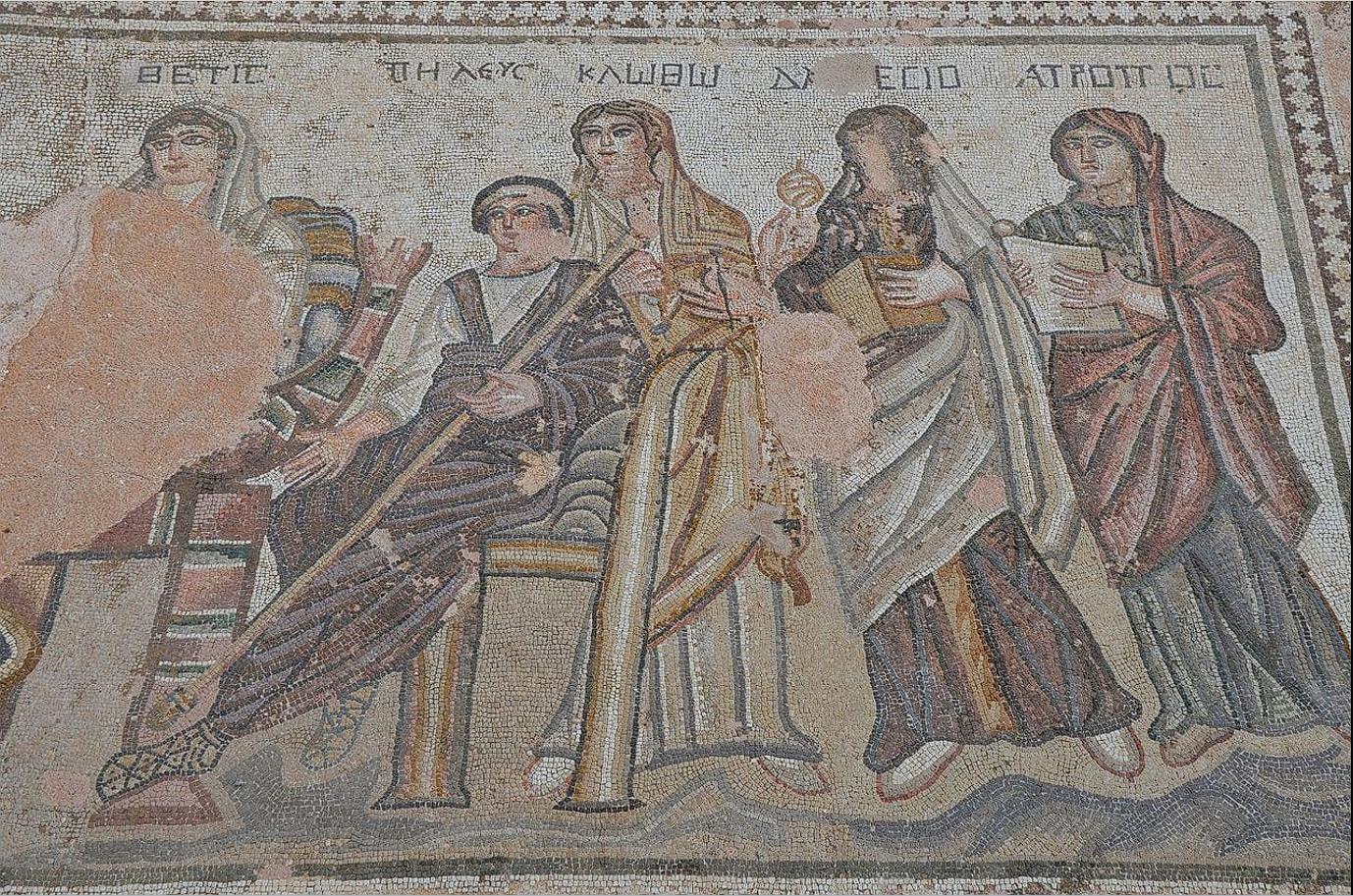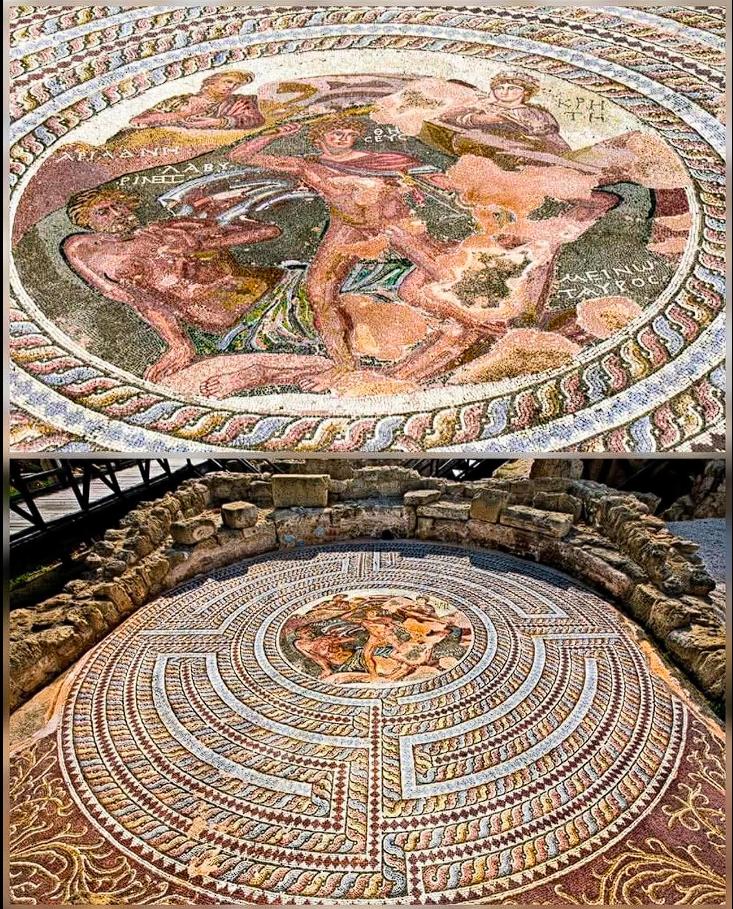The House of Theseus in Pafos, Cyprus, stands as a testament to the opulence and artistry of Roman villas, most notably through its exquisite mosaic floors. Dating back to the 3rd or 4th century AD, this villa, featuring the iconic scene of Theseus battling the Minotaur, offers a captivating glimpse into the cultural heritage and craftsmanship of ancient Cyprus.
The Architectural and Artistic Splendor of the House of Theseus
The House of Theseus showcases the grandeur of Roman villas through its architectural design and the exceptional quality of its mosaic art.
Roman Villa Architecture
The villa’s architectural design reflects the typical layout and features of a high-ranking Roman official’s residence, highlighting its historical significance.

- High-Ranking Residence:
- Believed to have been the residence of a high-ranking Roman official, the villa’s size and design indicate the status and wealth of its inhabitants.
- It was a high-ranking residence.
- Layout and Features:
- The villa’s layout includes courtyards, rooms for various functions, and elaborate mosaic floors, showcasing the architectural sophistication of the Roman period.
- It had a specific layout.
- Historical Context:
- The villa’s architecture provides valuable historical context, offering insights into the daily life and social structure of Roman Cyprus.
- It provides historical context.
Breathtaking Mosaics
The House of Theseus is renowned for its breathtaking mosaics, which are among the finest examples of Roman mosaic art in Cyprus.
- Iconic Theseus and Minotaur Scene:
- The iconic scene of Theseus battling the Minotaur is a masterpiece of mosaic art, capturing the dramatic moment of the legendary myth.
- It depicts the Theseus and Minotaur scene.
- Artistic Excellence:
- The intricate details and vibrant colors of the mosaics demonstrate the artistic excellence of the Roman craftsmen.
- It shows artistic excellence.
- Cultural Narrative:
- The mosaics serve as a cultural narrative, depicting mythological scenes and reflecting the artistic preferences of the Roman era.
- It tells a cultural narrative.
Intricate Floor Mosaics
The intricate floor mosaics of the House of Theseus showcase the technical skill and artistic vision of the Roman mosaicists.

- 3rd-4th Century AD Dating:
- Dating back to the 3rd or 4th century AD, the mosaics reflect the artistic trends and techniques of that period.
- It dates to the 3rd-4th century AD.
- Technical Skill:
- The precise placement of tesserae and the detailed rendering of figures demonstrate the technical skill of the mosaicists.
- It shows technical skill.
- Artistic Vision:
- The artistic vision displayed in the mosaics highlights the creativity and imagination of the Roman artists.
- It shows artistic vision.
The Myth of Theseus and the Minotaur
The iconic mosaic scene of Theseus battling the Minotaur in the House of Theseus brings to life one of the most famous myths of ancient Greece.
Legendary Battle
The mosaic captures the legendary moment when Theseus defeats the fearsome Minotaur within the Labyrinth of Crete.
- Athenian Hero:
- Theseus, the Athenian hero, is depicted as a symbol of courage and strength, overcoming the monstrous Minotaur.
- Theseus was an Athenian hero.
- Minotaur’s Defeat:
- The depiction of the Minotaur’s defeat represents the triumph of good over evil, a common theme in ancient mythology.
- The Minotaur was defeated.
- Labyrinth of Crete:
- The Labyrinth of Crete, a complex maze, adds to the drama and intrigue of the myth, highlighting the challenges faced by Theseus.
- It took place in the Labyrinth of Crete.
Cultural Significance
The myth of Theseus and the Minotaur held significant cultural importance in the ancient world, reflecting themes of heroism and societal order.
- Heroic Themes:
- The myth explores heroic themes, such as courage, determination, and the ability to overcome obstacles, which resonated with ancient audiences.
- It explores heroic themes.
- Societal Order:
- The defeat of the Minotaur symbolizes the restoration of societal order, highlighting the importance of justice and balance in ancient societies.
- It shows societal order.
- Artistic Representation:
- The artistic representation of the myth in the House of Theseus underscores its enduring popularity and cultural relevance.
- It had artistic representation.
Mythological Narrative
The mosaic’s depiction of the Theseus and Minotaur myth serves as a visual narrative, bringing the ancient story to life for modern viewers.
- Visual Storytelling:
- The mosaic’s visual storytelling allows viewers to experience the myth in a tangible way, connecting with the ancient world.
- It uses visual storytelling.
- Historical Connection:
- The depiction of the myth provides a historical connection to ancient Greek and Roman culture, highlighting the shared heritage of the Mediterranean region.
- It provides historical connection.
- Enduring Appeal:
- The enduring appeal of the Theseus and Minotaur myth is evident in its continued representation in art and literature.
- It has enduring appeal.
The House of Theseus in Pafos Today
The House of Theseus in Pafos remains a significant archaeological site, attracting visitors and researchers from around the world.
Archaeological Significance
The villa’s archaeological significance lies in its well-preserved mosaics and its contribution to our understanding of Roman Cyprus.

- Preservation of Mosaics:
- The preservation of the mosaics allows researchers to study the techniques and styles of Roman mosaic art in detail.
- The mosaics are preserved.
- Roman Cyprus Insights:
- The villa provides valuable insights into the social, cultural, and economic life of Roman Cyprus.
- It shows Roman Cyprus insights.
- Historical Research:
- The site continues to be a subject of historical research, contributing to our knowledge of the Roman Empire and its provinces.
- It is used for historical research.
Visitor Experience
Visiting the House of Theseus offers a unique opportunity to experience the grandeur of Roman villas and the beauty of ancient mosaic art.
- Exploring the Ruins:
- Exploring the ruins of the villa allows visitors to imagine the lives of its ancient inhabitants and appreciate the architectural design.
- Visitors can explore the ruins.
- Viewing the Mosaics:
- Viewing the mosaics firsthand provides a tangible connection to ancient art and mythology, enhancing the visitor experience.
- Visitors can view the mosaics.
- Cultural Heritage:
- Visiting the site offers a cultural heritage experience, providing insights into the history and art of Cyprus.
- It is a cultural heritage experience.
Cultural Heritage of Cyprus
The House of Theseus is an integral part of the cultural heritage of Cyprus, attracting tourists and promoting the island’s rich history.
- Tourist Attraction:
- The villa is a popular tourist attraction, drawing visitors interested in ancient history and archaeology.
- It is a tourist attraction.
- Historical Promotion:
- The site promotes the island’s rich history and cultural heritage, contributing to the development of cultural tourism.
- It promotes historical sites.
- Educational Value:
- The House of Theseus offers educational value, providing opportunities to learn about Roman art, architecture, and mythology.
- It has educational value.
The House of Theseus in Pafos, Cyprus, with its breathtaking mosaics and historical significance, stands as a remarkable testament to the artistry and grandeur of Roman villas. Its enduring appeal continues to attract visitors and researchers, offering a captivating glimpse into the cultural heritage of ancient Cyprus.

CÁC TIN KHÁC
Mary Walton: The Forgotten Inventor Who Helped Clean Up America’s Cities
Tomb of Queen Nefertari in the Valley of the Queens, Egypt
Discover the Hypostyle Hall of the Temple of Hathor at Dendera
Venus de Losange: Unveiling the Mystery of a 20,000-Year-Old Paleolithic Icon